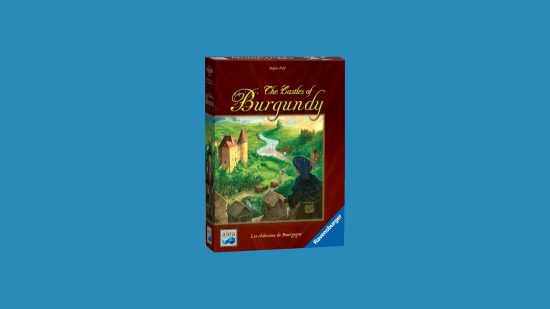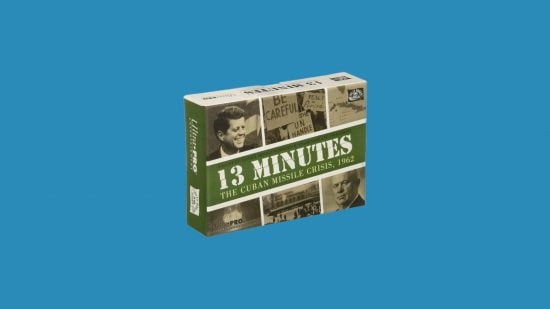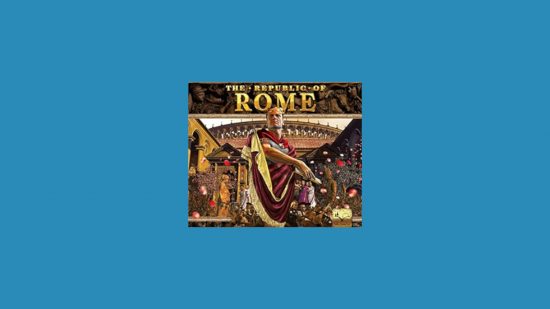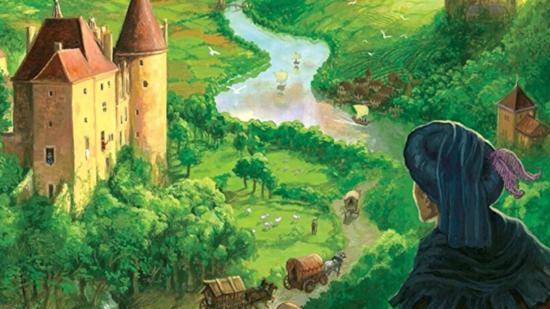Historical board games have a unique appeal – there’s a reason game designers so often look to their favourite historical eras, characters, and concepts as a source of aesthetic inspiration, mechanical flavour, or novel scenarios. It’s one of the most pervasive, popular board game themes ever – so we’ve scoured the annals to produce this list of our all-time, old-timey favorites.
Choosing the best historical games, we’ve made room for different historical eras and genres (you’ll find more than traditional WW2 board games and heavyweight strategy board games here.) Some are classics constantly in contention for a spot in our best board games guide, even.
We’ve also picked out games that best leverage their historical settings in their central mechanics – they don’t merely paint their glossy cardboard with the paraphernalia of a historical setting, but build its key themes, events, and cultural phenomena right into the threads of gameplay.
The best historical board games are:
- Castles of Burgundy – best overall
- 13 Minutes: The Cuban Missile Crisis – best Cold War game
- Axis & Allies 1940 Second Edition – best WW2 board game
- Dominant Species – best dinosaur board game
- Friedrich – best Prussian board game
- Sekigahara: The Unification of Japan – best feudal Japan game
- Escape from Colditz – best POW board game
- Pax Porfiriana – best Mexican historical board game
- Pavlov’s House – best Stalingrad board game
- The Republic of Rome – best Roman board game
If you’re not so much into the olden days stuff, take a broader perspective with our overall guide to the best board games available.
Of course, we couldn’t capture all eras on this list, and eurocentrism unfortunately remains a pervasive problem in the contemporary board gaming hobby. But, if historical board games are your jam, you won’t find a better list than ours.

1. Castles of Burgundy
The best historical board game.
Transporting you to the eminently romantic, if horribly smelly, realm of medieval France, Castles of Burgundy hands you a little princedom of your own, and tasks you with expanding its populace and borders through constructing new settlements. Players are given individual hex boards to represent their aristocratic realms, pick tiles to form the central game board, and expand their territory while enacting the tiles’ various effects.
But you can’t go grabbing just any tile you like the look of. The people of your princedom are a demanding bunch, and each hex of your board is assigned a specific color and dice number, dictating what kind of settlement may be built upon it. What’s more, the tiles made available to you on each turn are dependent upon the roll of the dice. Complete entire coloured districts for big scores, group tiles types together for extra points, or block your enemy’s advances by stealing that one tile essential to their growth.
Castles of Burgundy fills a specific niche of light strategy. Dice rolls drive action, but never arbitrarily impede your advances – they are the method through which you make decisions, rather than a brick wall to your plans. You’ll be readjusting your strategy on the fly, and never reach a dead end – there is always something to do on your turn, some glimmer of hope to your expansion. Running on straightforward rules that helpfully rely on the game’s tiles and board to do much of the heavy lifting, it can be picked and played quickly, while providing as much depth as you’re willing to give it.
There’s also a card version of the game available, which plays in much the same way, but strips out the central and player boards. Not especially better or worse, we prefer the original version for its colorful centerpiece and better visualization of your expanding territory. But the card variant is slimline and perfect for those keen to show off their Burgundian bastions all around town.

2. 13 Minutes: The Cuban Missile Crisis
The best Cold War board game.
Looming nuclear war, global ideological warfare, Kennedy vs. Kruschev – 13 Minutes: The Cuban Missile Crisis captures all the tensions of the Cold War in a quick, two-player micro-game of only 13 cards and a bunch of cubes. The tabletop becomes the world stage, as cards are laid down to simulate ongoing geopolitical events. It’s your job to bring these battlegrounds under your control by placing more ‘influence cubes’ on them than your opponent.
Of course, you can’t go throwing cubes around haphazardly. Each turn, you must decide which of the two cards in your hand to place down, distributing your influence across the map, with the cards themselves acting as new battlegrounds to vie for and expanding the conflict arena.
With simple turn-taking that adopts a rhythm similar to the quick-fire card game Love Letter, 13 Minutes also takes a lesson from the gargantuan beast Twilight Struggle, by allowing your opponent to switch the effects of your cards. You’ll need to be careful handing them too many opportunities to influence the tableau, while maintaining a firm check on the distribution of your own influence. Oh, and be sure not to play three cards with the DEFCON symbol, or you’ll cause nuclear armageddon, instantly losing.
If you need more convincing, 13 Minutes is a streamlined card adaptation of the popular 13 Days board game, which is itself a distilled version of the acclaimed, and forever intimidating, Twilight Struggle. If you don’t feel like investing hours into a complicated mess of hardcore, strategic chit-shuffling antics, 13 Minutes provides all the Cold War capers necessary in more of an ‘amuse-bouche’ form factor.

3. Axis and Allies 1940 – Second Edition
The best WW2 board game.
A WW2 game on a grand scale, yet light on complexity, Axis and Allies 1940 is a classic game of territorial control that’s barely more complicated than Risk. Playing as one of the war’s major belligerents, you’ll be spending production points on mustering new units, and repairing damages, before distributing your forces across your borders, and moving into enemy territory – resolving the ensuing battles with dice rolls.
The game’s initial setup goes some way to reflect the political make-up of the world in 1940, but you’ll be declaring war on other factions of your choice as the game progresses, gradually expanding in territory to complete your pre-determined win conditions. A mix of land and naval units, alongside varying rules of engagement, add greater variety to the ‘biggest army wins’ warfare of the classic board game Risk, and make for more subtle and nuanced strategic options, beyond simply amassing the biggest force possible to plough unstoppably through enemy territory. Coastal assaults, airbase attacks, tank-led blitzkrieg offensives, and defensive scrambles can be powerfully employed to cut off enemy advances and shore up your own power, or strike out at valuable targets around the map.
There are a lot of conditional rules and specific turn possibilities to learn, but none are overly complex. You’re handed a broad range of possibilities to carry out a single, simple procedure – attack the enemy with the most formidable force manageable. Boxed with an array of plastic miniatures – from submarines to infantry, to fighter planes – Axis & Allies is a great pick, both for paid-up strategy buffs and for more casual board gamers keen to expand their horizons.

4. Dominant Species
The best dinosaur board game.
It’s not easy being a dinosaur. Not only are there other gargantuan beasties plodding around, ready to chomp you in half before you can even get a good look at their feathers, but the environment is also in dire straits, as species migrate, temperatures rise and fall, and sea levels fluctuate, threatening the survival of your kind. With an ice age fast approaching, you’ll have to rely on all your wiles to stay ahead of the pack.
Across a modular hex board. Dominant Species challenges you to ensure the survival of one prehistoric species during an environmental emergency. Players take on the role of one of six animal classes – amphibian, mammal, bird, arachnid, insect, or reptile – enhancing their own survivability, while hindering that of their opponents amongst the changing environmental circumstances.
Propagate your species and multiply across the board to score points. But it’s not a simple case of placing down roots wherever you feel at home. Species have distinct elemental needs, and may only spread to tiles that can satiate their biological functions. Alter the elements of the board to let your species flourish and diminish the survivability of others, and build up a large enough presence to ‘dominate’ a tile, earning powerful abilities that can shift the tide even further in your favour – like eliminating a whole species on a given tile. In this game of survival of the fittest, no holds are barred.
What’s that I hear you say? Dinosaurs existed in the pre-historic Mesozoic era, so Dominant Species cannot qualify as an entry on this list of historical board games? Maybe, but we’ll ignore your fiddly semantic criticism and proceed anyway, because, in this case, we’re talking about natural history. Plus, dinosaurs are big, old, and dead, so qualify as historical by default.

5. Friedrich
Best board game based on Prussian history.
A historical simulation game tracing the events of the Seven Years’ War in Central Europe in the mid-18th century, Friedrich may appear to be a sprawling grand-strategy title of complex scope and depth, it operates more like a slimmed-down game of survival. Prussia must desperately hold out against the territorial advances of Russia, Austria, and France, who will be maneuvering their generals city-to-city to capture objective territories. If Prussia – and its King, Friedrich II – can stay their advances before the opposing heads of states surrender or are killed, they’ll succeed. Otherwise, old Fred’s time on the throne is at an end.
What makes the game stand out from the rest is its close attention to historical detail, translated into novel gameplay mechanics. Historical events will regularly occur throughout the game, radically disrupting the balance of power. Some increase the movement of a general or wipe an army from the map in a freak accident. But, more tantalizingly, they can even remove whole nations from play. Instead of players eliminating countries through military dominance, the only means for a nation to lose is through the historical event cards. kicking them from the game; when the Tsarina dies, for example, that’s Russia out of the equation. After their nations are knocked out, players take the helm of other countries vying for control but are given new nation-specific objectives to compete for.
Much of the game operates like chess, distributing counters across the map to pincer your opponent or take advantage of the portion of the map left weak and vulnerable. Mix in a dash of asymmetric rule systems and refined faction balancing, you’ve got yourself a peculiar strategy game that recreates the epic military campaigns of 18th-century Europe without getting bogged down in mountains of chits and a doorstop of a rulebook.

6. Sekigahara: The Unification of Japan
The best feudal Japan board game.
A unique blend of traditional blocks-on-a-map wargame, card play, and bluffing, Sekigahara: The Unification of Japan places you at a crucial crossroads of Japanese feudal history, in a two-player game of harrying warfare. One player will assume the role of incumbent daimyo Tokugawa Ieyasu; the other, his rival and challenger of the Shogunate, Ishida Mitsunari. Try and claim autocratic domination of Japan, not merely by raising a formidable army, but by cultivating the loyalty of enough supporters, and encouraging defection from your opponent to turn the tide of battle.
Much of the game involves traditional wargaming fare. Recruit units represented by wooden blocks, distribute them across the board to shore up defenses and bolster battalions, and traverse across networks of roads to seize castles, territory, and resource supplies.
But the game really shines in its card mechanics. Armies will only fight battles if you’ve enough cards of sufficient loyalty to call upon them, and unit placement and movement are restricted by the number of cards you can discard. Hands are replenished after battles or sieges, and more cards assigned depending on their combat results. Bluffing takes on huge importance. Squarely fix your poker face, and convince your opponent of the bountiful loyalty you enjoy amongst your troops, hiding the true meager selection in your hand.
Dense and long, Seikighara is intended to provide a historically authentic take on the unification of Japan as a mechanically streamlined game. The game’s board replicates the major battles and locations of strategic interest in 1600s Japan and comes with six full pages of ‘historical notes’ in its rulebook, but operates through a regular, and largely intuitive turn cycle.

7. Escape from Colditz
Best POW board game.
A stone-cold classic, Escape from Colditz lets you live out your very own prisoner-of-war escape movie. One group of players must try to escape the confines of WWII’s infamous castle-turned-prison, moving their counters across the board to collect the necessary equipment and make their daring escape. But they’ll have to be wary, as another player will be controlling the German prison guards, chasing the prisoners and confiscating their illegal contraband.
With simple mechanics that’ll be familiar to anyone whose board game experience only extends to the casual world of Cluedo, the game’s charm comes from its consistent tension. Racing around the board to claim escape kits while evading guards, players can collaborate through trading items, or creating a deliberate ruse to draw the jailor’s attention (and manpower) away from the real escape effort. But coordination is no easy task. With the game’s turn counter ticking away, each escapee eventually will find themself deliberating whether helping their prisoner buddies is really so effective, or hoarding items for themself in the hope of a big win might be the quickest way out.
Not the most strategy-heavy game, you’ll be spending most of your time rolling dice to move counters around the board, occasionally trading with players, and formulating plans of action between you on the fly. In many ways, the German player has the toughest job, keeping tabs on every player and their equipment, and moving their roster of guards about the map in anticipation of their breakout plans.

8. Pax Porfiriana
Best historical Mexican board game.
Sister to the much acclaimed Pax Pamir, Pax Porfiriana transports you to pre-revolutionary Mexico to build a mighty business empire and seize leadership of the country during one of its periodic instances of turmoil. Channel investments to banks, mines, railways, and ranches, while constructing a network of allies and troops to extort money, and fund further expansion, all the while looking to gather the much coveted ‘prestige’ points, justifying your seizure of power.
Played between two to six players, Pax Porfiriana operates as a card-drafting game, in which players spend gold picking cards from a common pool to boost their economic output and impede the expansion of others. But progression is not simple. Cards’ income rates vary drastically, from providing fixed gold per turn to offering improvable returns to offering changing remuneration dependent upon the strength of the whole economy.
At other times, you’ll be looking to disrupt others’ money-making schemes, using paid troops or targeted rebellions to switch income streams or start a spin war by buying headlines in the national press. All actions, however, are dependent on external conditions being met or outside factors lining up.
A long game that can overwhelm you with information, so don’t expect an easy ride. Each card is dense with information and little explanatory help, so have a firm grasp of the rulebook before venturing into a game. But, for a card-drafting game that excels at player interaction, and scheming, and leans heavily – both mechanically and artistically – into a much-overlooked historical setting, it will transport you back to the vicious world of pre-revolutionary Mexico.

9. Pavlov’s House
Best Stalingrad board game.
Handing you command of a group of Soviet soldiers defending a fortified apartment building from relentless German assaults during the Battle of Stalingrad, Pavlov’s House is a game of survival. You must fend off German attacks until reinforcements arrive, while elsewhere commanding leaders of the Soviet 62nd Army to provide essential support and aid to the defenders inside the building, hoping your defences hold and offensive capabilities stay strong, before sallying forth in a glorious counter-offensive.
Each turn, attacks are simulated by drawing from a randomised deck of cards, dictating the force and direction of the German offensive. You must respond to these attacks, coordinating troops around the building for suppressive fire, but always wary to preserve the life and strength of your dwindling forces. Survive until the deck is depleted, and you’ll claim victory, but let too many bullets find their way inside, and you’ll be quickly overrun.
Pavlov’s House is playable solo, cooperatively (with one player taking command of the apartment’s defenders and the other controlling the supporting Soviet Army) or competitively (with another player commanding the German forces), and a digital version of the game is also set for release this April. Rather disappointingly, neither the game, nor the apartment building, have anything at all to do with the Russian physiologist Ivan Pavlov, famed for his experiments in biological conditioning.

10. The Republic of Rome
Best Roman board game.
Is any period of history so storied, so illustrious, so prone to mythological interpretation as the Roman Republic? An expansive empire built on military might and pernicious labour exploitation, with a fractured senate more prone to factionalist betrayals between feuding nobles than smooth enactments of democratic will, Rome’s power was as vulnerable to crumbling from within as it was to attacks from the ’barbarians’ beyond its borders.
The Republic of Rome gets this romanticism, fully leaning into its thematic setting to deliver a game of cunning and avarice. You’ll take the role of one of many factions competing for dominance in the Roman senate, building your power through earning the loyalty of noble families, state officials, and military commanders, convincing them to enact favourable policies in return for equally glorious titles. Manipulate state revenue to earn dosh at the cost of unrest, persuade senators to follow your faction, attempt to start a popular war, or trade cards with other players, always looking to gain an edge.
But all the while, you’ll have to cooperate with the players sitting opposite, to protect yourself from hostile threats and prevent the republic from sinking under a rising tide of famine, bankruptcy, and public unrest. Carefully plot your charitable actions to save the nation, but make sure you’re always one step ahead of the competition.
A massive game playable with one to six players, The Republic of Rome can take hours to complete, and hands you reams of possible actions on any one turn. Even split into distinct phases, you’ll be continuously reminding yourself of the many, shifting, actions at your disposal, anticipating your opponents’ next play, while leveraging your own limited resources for the greatest effect.
Chunky board games like these take a lot of space to play, and put away – luckily we’ve got helpful guides to the best gaming tables and board game storage solutions to give you a hand. Or has this journey down the winding, romantic roads of historical board games got you hunting a game to play with your loved one? We have you covered – check out our guide to the best board games for couples.
